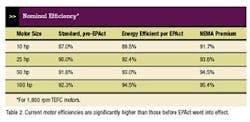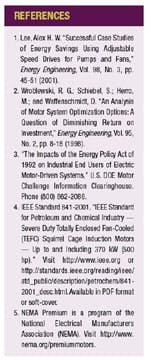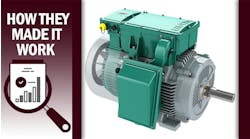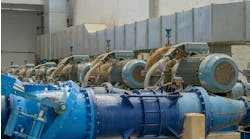By Darrell T. Mears
As summer approaches, the "spring cleaning" is nearly done, the golf scores are improving, the days are getting longer, the electric loads are increasing and the higher summer electric rates are about to go into effect. As your electric bill approaches its annual peak, perhaps it's time to contemplate which electric motors in the plant contribute most to the bill and do some "spring cleaning" of your own.
Electric motors in continuous or near-continuous service have high energy costs, even at the relatively low electric rates common in much of the chemical industry (Table 1). Unfortunately, the savings from motor efficiency improvement will rarely justify motor replacement on its own.
Example: An aging 100 hp, 1,800 rpm, totally enclosed, fan cooled (TEFC), standard-efficiency AC motor runs at 92.1% efficiency at 75% load and at an electric rate of 4 cents/kWh. In continuous service, this motor contributes more than $22,000 to the annual electric bill. A new energy-efficient motor in the same service will offer about 3% higher efficiency. That's worth about $700 per year in electric bill reduction, but replacing the original motor costs more than 10 times that amount.
These economics can halt efficiency upgrade projects so that original motors are replaced only after they have failed. A delay in planning efficiency upgrades, however, is risky because it may squander related savings opportunities or lead to potential perils of specification in haste. Here are eight prerequisites for replacing existing motors with more efficient models.
- If motor load is highly variable, you may obtain substantial energy savings by installing an adjustable speed drive (ASD), such as a variable frequency drive (VFD). Prematurely installing a higher-efficiency motor will adversely affect ASD project payback, and a new motor chosen for efficiency upgrade may not be the optimum choice for operation with an ASD. Review all ASD applications before evaluating motor upgrades.
Unlike immediate motor replacement, immediate ASD installation may have a good payback. For example, one published study of nine cases of pump and fan ASD applications demonstrated measured energy savings in the range of 23% to 79% in the 7.5 hp to 125 hp motor size range [1].
Adapt to process evolution
- Process design sometimes requires a crystal ball. Pump specification and selection on new projects, for example, often has to be well under way long before the process loads and requirements are final. The result can be an over-design of the pump, where excessive capacity and excessive total head capability are built into the design. This over-design "margin" often escapes the commissioning team, so pump motors often begin life well away from their best efficiency points.
Process evolution can also lead to having a piece of process equipment operate far off its original design point, and any correction of "margin" and process evolution should be considered prior to re-specifying the motor. Look for indications of process evolution such as throttled discharge valves, simultaneously running parallel standby pumps, excessive bypassing and severe vibration. As with ASD installation, correcting these inefficient operations can be more lucrative than motor efficiency upgrades and should take a higher priority.
For example, a centrifugal pump may benefit from impeller trimming to adjust the operating point. Many impeller trimmings pay for themselves in just a few months. Sometimes the choice is between an ASD and an impeller trimming, and the impeller trimming wins on the basis of lowest cost, lowest risk and sheer simplicity [2].
Process evolution may result in low motor load, but don't let low motor load hijack the pump, fan or blower analysis. The common notion that motor efficiency plummets at part-load conditions is largely myth; electric motor part-load efficiency can sometimes be slightly higher than the full-load efficiency, and large electric motors maintain relatively high efficiency even down to the region of roughly 50% load. You should correct the problems on the process end before addressing any perceived problems on the electrical end.
It's all in the timing
Once you address variable loads and process evolution, you can proceed with the specification of a new motor. The best time to select an energy-efficient or premium-efficiency replacement motor is before the original motor fails in the middle of a production run and the production manager demands everyone's attention to avert a crisis. In crisis mode, some possible, but dubious, motor selection procedures include:Under such circumstances, even maintaining efficiency may be difficult. Your maintenance plan should be more proactive than that. Many aren't, but even if yours is, there are still a few additional considerations that you should address well in advance of motor failure.
Avoid the full-load speed trap
The "affinity laws" indicate that the power requirement (i.e., brake horsepower (bhp)) of a centrifugal pump or fan varies as the cube of rotational speed (rpm).(bhp2/bhp1) = (rpm2/rpm1)3
This approximation is good news if you decrease the speed after installing an ASD, but it's bad news if you increase the speed through a motor replacement. If an existing 1,800 rpm motor runs at 1,745 rpm at full load and you change it to a new, energy-efficient motor that runs at 1,775 rpm at full load, there may be enough additional load to offset any gain from improved efficiency.
(1,775 / 1,745)3 = 1.05
Or, a 5% increase in load.
Fortunately, it may be possible to find a new energy-efficient motor with a full-load speed closer to that of the original motor. If not, an impeller trimming can provide the required adjustment.
Rules and exceptions
The U.S. Energy Policy Act of 1992 (commonly called "EPAct") eliminated the least efficient motors from the market and raised the bar for many motors manufactured since October 1997 (Table 2). That does not, however, negate the need for motor shopping for optimum efficiency. There is an acceptable range of efficiencies for any given motor size. Your application may warrant a selection in the premium end of the range. In many cases, though, any new motor will have a higher efficiency than the old motor.EPAct does not guarantee a good motor efficiency selection since many motors are exempt from EPAct requirements. Exempt motors include motors larger than 200 hp; non-foot-mounted motors; rebuilt, repaired and rewound motors; and NEMA Design C and D motors [3].
Check your spec
Chances are your organization already has a motor specification. Is it up-to-date?If you need a motor specification, consider referencing IEEE Standard 841 for severe duty, TEFC, squirrel-cage induction motors up to 500 hp [4]. You'll get heavy-duty motors with energy efficiency higher than EPAct requirements. Consider adding the NEMA Premium efficiency standard [5] for even higher efficiency (Table 2) and adding IP 55 bearing isolators under 40 hp. (They are already included for 40 hp and above.)
How high a quality will that get you? Hint: Most motor manufacturers provide a 60-month warranty for IEEE 841 motors instead of the usual 12-month warranty for standard EPAct motors.
Don't forget to "clip coupons"
Electric deregulation eliminated many rebate and incentive programs for installing energy-efficient motors. However, some programs still exist. To determine whether rebates or incentives are available, call your account representative at the electric company.Be sure to get program details before specifying new motors because the rebates or incentives may require approval in advance of purchase. The program requirements may partially guide your choices. For example, the rebates or incentives often only apply in the premium end of the efficiency range, and you may find that the rebates or incentives cover much of the premium price associated with the premium efficiency.
Learn all you can
There are many excellent sources of information about motor selection and upgrade for energy efficiency. Your preferred motor supplier is one source.Another source is the U.S. Department of Energy (DOE). DOE's free non-commercial source for guidance is the "BestPractices" program of the Office of Industrial Technologies (OIT). You can find motor tip sheets, case studies, technical publications, software to download, and training and event schedules on their Web site at http://www.oit.doe.gov/bestpractices/motors.
OIT downloadable publications include titles such as:
There are also more extensive publications, such as "Energy Management for Motor Driven Systems."
OIT software includes:
A rewarding replacement
Properly pursuing electric motor replacement for energy efficiency requires an awareness of numerous potential opportunities and pitfalls. Opportunities such as ASD installation and process optimization may have a significantly better return on investment than motor replacement. Lack of advance attention to motor replacement details, such as small speed differences in centrifugal equipment applications, can be costly. Fortunately, detailed motor replacement information and analysis tools are readily available, and many of them are free.If you consider all these details before replacing an electric motor, you will rev up energy savings every time.





